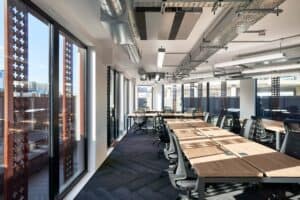As Earth Month 2025 inspires conversations about environmental responsibility, businesses are discovering that sustainable workspaces deliver benefits far beyond ecological impact. Modern sustainable office space isn’t just good for the planet – it’s a strategic business decision with measurable returns.
Recent research shows green buildings command 18% higher rental values and enjoy 26% lower vacancy rates than conventional spaces. But the true value extends much deeper, directly impacting your operational efficiency, talent strategy, and brand positioning.
Energy savings
Tax incentives & reduced costs
Lower maintenance expenses
Enhanced recruitment
Improved retention
Productivity boost
For a company with 50 employees earning an average salary of £50,000, a 23% productivity improvement represents approximately £575,000 in annual value.
Better air quality
Natural light
Biophilic design

Enhanced brand image
Competitive Edge
At Work.Life, sustainability isn’t a separate initiative — it’s built into how we think, plan, and operate. As we’ve grown to 13 shared workspaces across the UK, our commitment to creating environmentally responsible, purpose-driven spaces has only deepened.
Over the past year, we’ve taken a significant step forward in our sustainability journey by establishing our baseline carbon footprint — a foundational move as we develop a comprehensive Net Zero strategy. Rather than treating sustainability as a checklist, we’re taking the time to understand our true impact and act on it with intent. This includes reducing operational carbon through smarter energy use in our spaces, reassessing lighting and air conditioning systems, and making informed improvements. We’re also looking beyond day-to-day energy use — evaluating the embodied carbon in our fitouts and working to reduce it through better, more sustainable design choices; and looking at our supply chains and working with our suppliers to identify opportunities to reduce our impact upstream and downstream of our operations.
One of our newest spaces, Borough, is a reflection of this mindset. It’s our greenest workspace yet, designed with a Bio Solar Roof expected to generate over 10,000kWh annually and a Building Management System to optimise energy usage. Crucially, it was built in collaboration with fellow B Corps — including both our landlord and fitout partner — who share our values and ambition.
Although environmental sustainability is a major focus for us, due to the nature of our business, our approach is holistic. It’s about creating long-term, positive impact in every part of our business — from managing supply chains responsibly, to supporting our people, strengthening communities, embedding transparency in governance, and delivering real value to our members.
That holistic view is reflected in the ecosystem we’re proud to be part of. Roughly one in seven of our member businesses are purpose-driven organisations, including around 30 certified B Corps. Together, they help shape a vibrant community where sustainable practices are not only supported but actively shared and scaled.
Looking ahead, we’re continuing to embed sustainability into our operations and decision-making — aligning with, and where we can, going beyond evolving global standards that emphasise transparency, accountability and long-term value creation. We know we still have a long way to go. But we’re committed to learning, improving and holding ourselves to account. Frameworks like B Corp will continue to guide our progress — helping us prioritise what matters and measure our impact as we grow.
The workspace of the future is more than a physical environment. It’s a platform that supports wellbeing, champions environmental action, and uplifts the communities within and around it. That’s the kind of future we believe in — and one we’re working towards, one workspace at a time.
This thinking has shaped the design of our newest project: Clerkenwell Green, opening August 2025. We’re excited to bring to life everything we’ve learned so far.
All of this has been at the forefront of our minds in designing our brand new space Clerkenwell Green – opening August 2025.
The benefits of sustainable office space extend far beyond environmental impact:
In 2025, sustainable workspaces are no longer a premium option – they’re a strategic business decision with quantifiable returns.
At Work.Life, our spaces support both environmental goals and business success. With our community of over 25 B Corps and 40+ purpose-driven businesses, we’re creating not just sustainable spaces, but a sustainable ecosystem where impact-focused organisations thrive together.
Ready to experience the benefits firsthand? Book a tour of any Work.Life location today.
Tailored solutions for growing teams
Adding 10 or more team members? That’s exciting — and we’re here to help! For teams like yours, we offer custom membership options designed to fit your needs perfectly.
Let us know some more information using the form below — we usually reply within an hour during business hours. Prefer to chat? Give us a call on 020 3349 8269 — we’d love to hear from you!